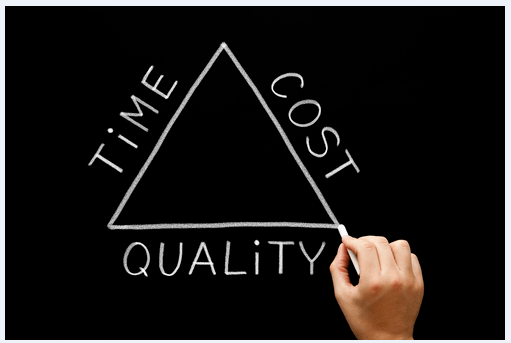5 Ways Τo Balance Τhe Time-Cost-Quality Triad Ιn eLearning Solutions
As an Instructional Designer at Allen Interactions, my teammates and I get very excited when clients engage us for new projects. We are thrilled to have another opportunity to create the most Meaningful, Memorable, and Motivational eLearning solutions possible. Some projects, from the very start, are described as “urgent” with extremely short timelines. I usually get nervous when I hear that description because it typically means something’s got to give… and that’s always a risk. Let’s face it, there’s no better way to drain the energy from a creative team than to tell them to hurry up!
Consider 1st century BC when words like “fast” and “cheap” would not be understood. The Roman engineer and architect, Vitruvius, spoke of a triangle, or triad, of qualities to consider when constructing a building – strength, utility, and beauty. Imagine the breathtaking architecture in Vitruvius’ time, the innovation required to envision it, and the passion for creating solid structures that has shaped architecture from the Renaissance to the present.
Instructional Designers carry that same passion for the solutions we develop. In fact, we can think of designing eLearning solutions as similar to Vitruvius’s construction in that it is also subject to a triangle of factors – cost, time, and quality. In our industry, these 3 factors go like this:
- Cost: “The project has to stay within the budget.”
- Time: “The project must be completed according to the project plan. Milestones are immovable.”
- Quality: “The project needs to produce measurable results.”
The theory behind the triangle is that you can optimize for two at the expense of the third, but you can't maximize all three at once. In other words, fast, cheap, and high quality is not a reality. It’s just not!
Of course, our goal is always to create high-quality eLearning solutions. And if this were 1st century BC, we’d probably have an empire’s budget to build the product at our leisure, in between visits to the Colosseum and toga parties. But, as the saying goes, it’s time to step out of the fiction section of the bookstore. The question for 2016 is, how can you develop a quality solution when cost and time constraints are present? Where do you cut corners?
Okay, that was a trick question. I don’t know a successful Instructional Designer who cuts corners. Here are 5 ways I’ve found to optimize quality with challenging timelines and budget in order to design high-quality eLearning solutions:
- Be informed right away.
Get an overview of the desired outcomes, budget, and timeline for a blueprint of the overall solution. You might have lofty ideas for designing a solution that the project simply can’t afford, and you’ll waste time redesigning that “really cool activity” when you could’ve scaled back from the start. - Be flexible in your approach.
Create and validate solid performance objectives, and then consider all of the treatment options for achieving them. Instructional Designers usually know more than one way to achieve an objective. Consider solutions that help your development team stay within the budget and timeline, yet still engage learners and allow them to build confidence. For example, rather than a multiple-branching simulation, would a scenario-based multiple-choice activity help learners improve their performance? You might need to let go of pre-conceived concepts and be open to alternative approaches. - Be mindful of how you define and organize the content.
When you’re working with Subject Matter Experts (SMEs) on a given topic, you may get more content and information than you really need. Choose the right level and amount of content to achieve the learning outcomes for the audience. If you try to force your learners to do too much and don’t focus on what’s important and relevant to them, you’ll actually decrease quality (business outcomes), wasting time and money. - Be firm with the learning and performance goals.
Don’t veer from the objectives, which can happen in the midst of a project when, for example, someone has new content to add to the course or a fun idea to try out. Unexpected obstacles can be costly and time-consuming, so manage the risks by bringing everyone back to the original goals. I’ve revisited objectives in the midst of many projects when new ideas surface to ensure we’re all still on the same page and to revalidate the goals of the course. - Be a consistent client advocate regarding scope and process.
Even after the design has been socialized and approved, expectations might creep. When stakeholders’ expectations exceed the budget and timeline, try to help them understand the situation. Maybe they don’t see the full project scope or understand how things are resourced. If you still get push-back, then your team may want to discuss a change of scope as an option.
Let’s acknowledge one more thing. Instructional Designers want to give learners the world and often feel disappointment when the budget or timeline won’t allow us to “knock their socks off”. We are truly passionate about being learner advocates and prefer not to be constrained by time and money. However, we function in the real world (not the fictional one at the bookstore) where project plans and budgets are a reality. Fortunately, many projects carry the right budget and timeline to meet all expectations. But when they don’t, you can see how to balance the triad to avoid sacrificing the quality of your eLearning solutions.

